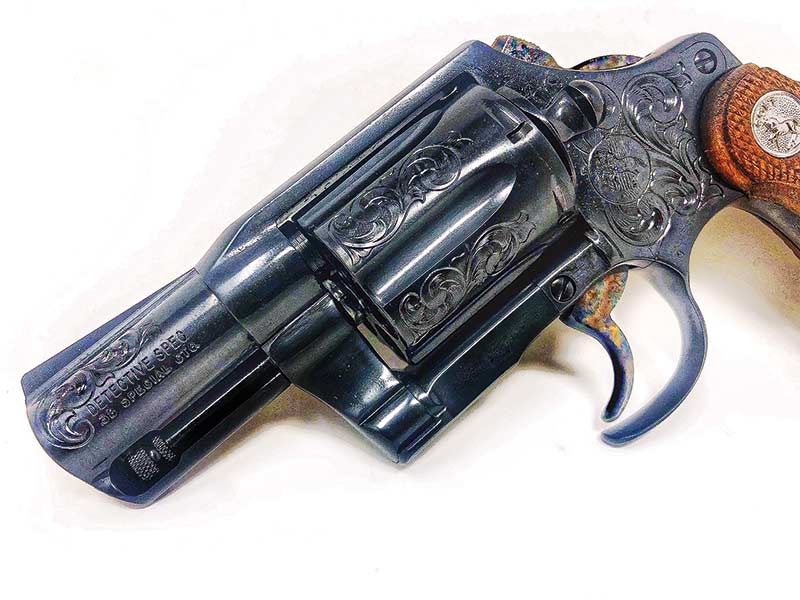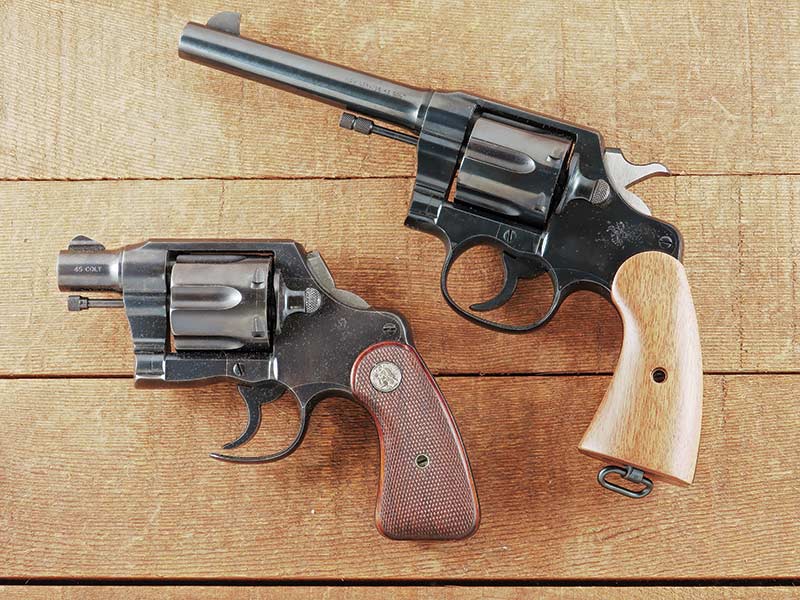The Singular Fitz Specials
Sixgun For The Connoisseur Gunfighter
I have often said the best part of my job of being a gun writer for nearly 55 years is not all the guns I get to test but the many interesting people I meet. Growing up I read of legends I did not realize, couldn’t even imagine, I would someday know. Five of these men were colonels — Rex Applegate, Charles Askins, Jeff Cooper, Bill Jordan and Walter Walsh. However, the beginning of my knowledge of these men goes back to the early 1950s when I was still a very young teenager:
“Speed guns are best made up with revolvers as the basic arm. My partner, George Parker, one time made up one of the most poisonous speed guns I have ever seen. He was a Border Patrolman at the time and wanted something that would be handy in the car and for undercoat carry when he was working in civilian clothes. He took the Colt New Service .45 and chopped the barrel off to 2″, then he rounded off the stock and shortened it somewhat. After this he dehorned the hammer leaving only enough on the hammer to give the needed weight to the firing pin. He cut out the front of the trigger guard so it would not impede a quick draw, and attached a ramp type front sight. The gun was chambered for the old .45 Colt cartridge not the .45 ACP and so had lots of stopping power despite the short barrel length. This weapon was remarkably fast out of a holster and was sufficiently shortened so it could be carried in a coat pocket or front trousers pocket with comfort. There was nothing on it anywhere that would catch in the clothing.
“Parker had gotten the idea for this gun from Henry FitzGerald, Grand Old Man of the Colt Co., who always had a matched pair in his pants somewhere. After I tried the Parker belly gun I made a somewhat similar shooting iron for myself.”
— Col. Charles Askins, The Pistol Shooters Book, 1953
These words had a lasting impression on me as I read them when I was 14 years old. All kinds of images sprang up in my mind and notice Col. Askins talks of what we now call high visibility sights being used before World War II. This was also my first introduction to the special sixguns of John Henry FitzGerald, also known as “Fitz.”
Mr. Colt
John Henry FitzGerald was “Mr. Colt” between the two World Wars, traveling to all the large pistol matches, shooting and fixing Colts and being a genuinely good ambassador for the company. Fitz was considered a firearms expert and spent much time lecturing and instructing both target and defensive shooting.
Before Clint Smith; before Mas Ayoob; before Jeff Cooper; even before Col. Applegate there was FitzGerald teaching principles and practices of quick shooting with a revolver. Not only was he a top shooter, he was also the designer of the Fitz Special. The Fitz Special started nearly 40 years before being discovered by Askins and Parker as Fitz started experimenting with the then-new Colt New Service.
“Perhaps some would like to ask why I cut up a good revolver and here is the answer,” he said. “The trigger guard is cut away to allow more finger room and for use when gloves are worn … The hammer spur is cut away to allow drawing from the pocket or from under the coat without catching or snagging in the cloth and eliminates the use of thumb over hammer when drawing … The butt is rounded to allow the revolver to easily slide into firing position in the hand … The top of the cut-away hammer may be lightly checked to assist in cocking for a long-range shot.” It was common knowledge among his contemporaries Fitz always carried a pair of .45 Colt Fitz Specials in his two front pants pockets. He definitely knew how to use them.
Special Tour
I had often read about and seen pictures of the Colt Fitz Specials but had never seen one, let alone handled one, but now I was about to. It was a rare privilege accorded me as I received a personally guided tour through the private museum of Col. Rex Applegate. Actually, three of us being hosted by the Colonel as I had traveled to the Oregon Coast with fellow writer Pat Cascio and we had stopped on the way to pick up another comrade, Chuck Karwan. All of us were personally acquainted with Col. Applegate and I had presented him with the coveted bronze as Outstanding American Handgunner in 1996.
The Colonel’s favorite possession as far as firearms go was found immediately inside the door of the museum. Actually it was one of two first items, as this sixgun was resting upon the base of the Outstanding American Handgunner Awards Foundation bronze. The highly modified revolver had started life as a standard Colt New Service .45 Colt probably with the same 5-1/2″ barrel as found on the well-known Colt revolvers of World War I, the Model 1917 .45 ACP. Then again, considering Col. Applegate’s many contacts, this revolver could be one of the very few specially manufactured as it now appeared. On the side plate were the words “TO REX FROM FITZ.”
Today
I have recently found I’m not the only one who appreciates Fitz Specials. I have made the acquaintance of retired sheriff Ken Campbell, the CEO of Gunsite Academy and he shared two of his Fitz specials with me as well as these words: “I have an infatuation with the Fitz revolvers and the history around them. Those that blather on and on about being unsafe because of the cut trigger guard need to read history and understand the time they were made, what men wore, etc. The real gunfighters of the time had Fitz-made revolvers.”
Campbell shared with me his engraved Colt Detective Special Fitz by Bobby Tyler. Tyler has built up several Fitz Specials, especially on the Colt Detective Special. My friend Jim Wilson, also a retired sheriff has one as well as friend and fellow Shootist Mark Hargrove, now chairman of the Shootists.
Several years ago I purchased a most interesting little sixgun. It was interesting for several reasons not the least of which it’s a .38 Colt Lightning that actually works but also for the fact it seems to be a very old and high quality Fitz Special. Just this week my friend Milt Morrison/QPR shared two Colt New Service Fitz Specials with me that belong to two of his customers who happen to be brothers. I found out they were commissioned by the brothers’ father, one in .44 Special and the other .45 Colt, and made up more than 20 years ago by a gunsmith in Anchorage, Alaska, the late John Wills. His work was absolutely of the highest quality and if any reader knows anything about this newly discovered gunsmith, I would certainly like to hear from you.
My Own
Col. Askins’ words stayed filed back in my mind for about four decades until I finally decided it was time for me to have my own Fitz Special.
A late-model New Service chambered in .44 Special was the starting point. Although it had some problems, it came at a very good price. I sent it off to one of the premier gunsmiths in the country, Andy Horvath.
Horvath said of this New Service: “It’s got a few miles on it and somebody got a little carried away with the buffing wheel. I bushed the cylinder to get out most of the endplay and installed a ball lock on the crane to help with the lock-up. Instead of cutting the old barrel, I just made a new one using up a piece of Douglas barrel blank too short for anything else. The sideplate screws are made from a Ruger base pin, as the old screws were polished until they were ugly. The grip frame has been shortened and rounded and fitted with fancy walnut grip panels, and the top of the hammer serrated for shooting single-action by starting the hammer back with the trigger and then grabbing the hammer with your thumb.
Andy polished and re-blued the little .44 Special with the result being I now have what has to be one of the finest Fitz Specials in existence built by one of the finest gunsmiths ever. It shoots like the proverbial dream and is very easy to handle using Speer’s 200-grain Gold Dot HP .44 Specials. These clock out at just under 750 fps in the 2″ Fitz Special, while my most-used everyday working load — the 250-grain Keith bullet over 7.5 grains of Unique — registers 830 fps, or just about the perfect equivalent of Fitz’ .45 Colt loads.
With all the choices we have for defensive handguns today, some might feel this was a waste of time, money, effort and a good sixgun. Going back in history to commemorate a special sixgun and special sixgunner is never a waste. For those who understand, no explanation is necessary; for those who don’t, none is possible.












